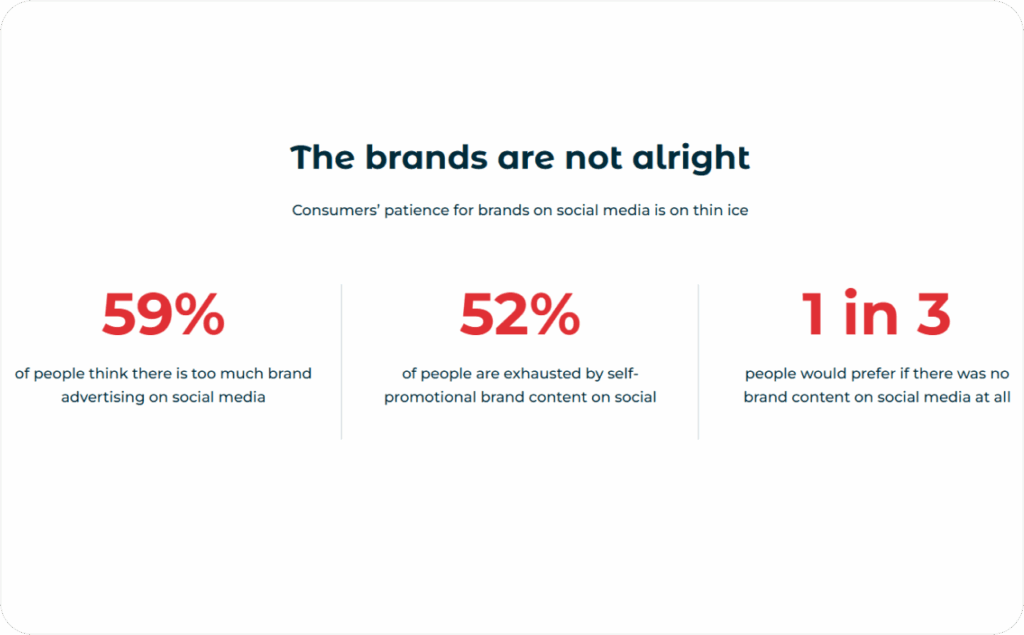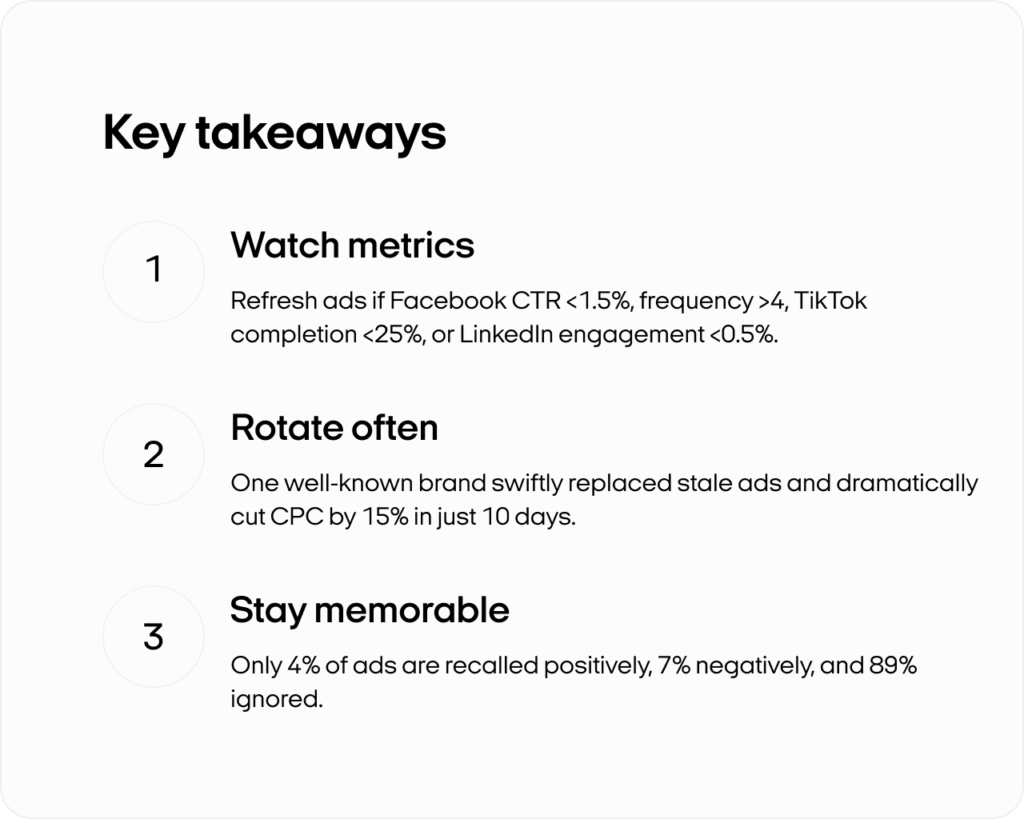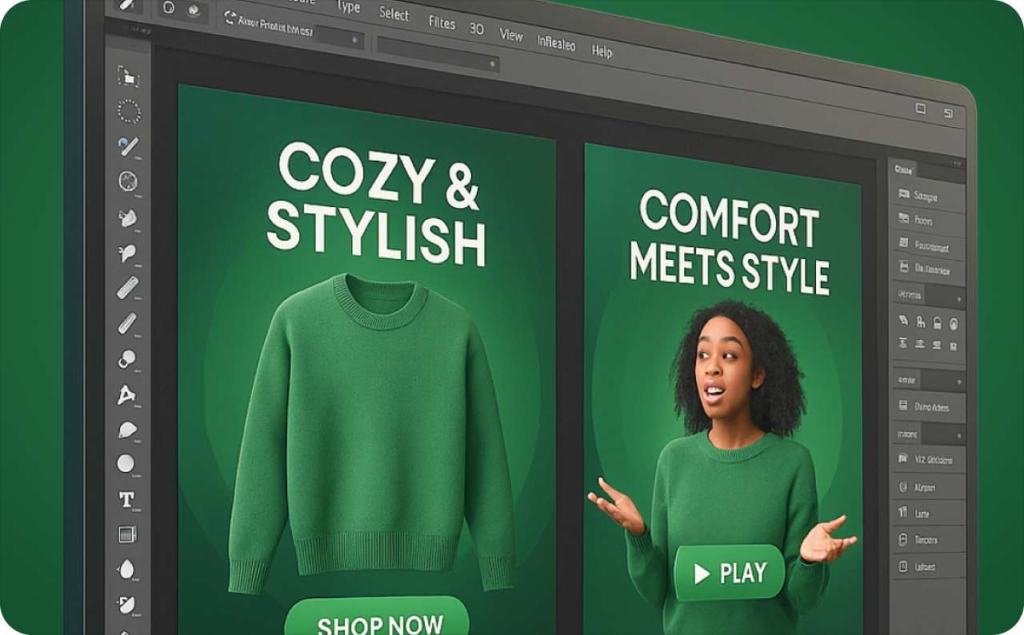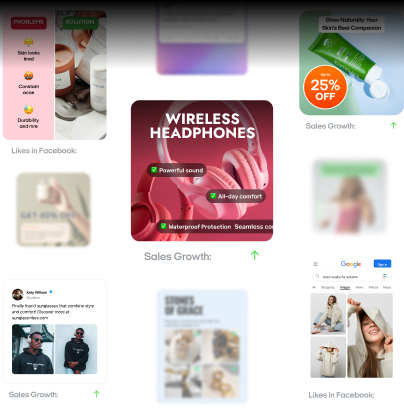Ad fatigue: Warning signs & 7 best practices to prevent it
Do your once high-performing ads suddenly stop converting? Here are the warning signs of ad fatigue and seven ways to keep your campaigns fresh.
If you’ve ever found yourself in a situation where a once promising ad suddenly loses interest, you’ll know that it’s all about ad fatigue. Also called advertising fatigue, ad saturation, or banner blindness, it’s what happens when users see your ads so often that they become disengaged.
For digital marketers and social media managers, ad fatigue is more than a nuisance — it can damage both your budget and your brand perception.
Did you know that click-through rates may drop by as much as 50% in a single week of repeated messaging? Complicating matters further, eMarketer found that 36% of US brands and agencies struggle with managing reach and frequency across multiple channels.
When you can’t control how many times each person sees your ad — whether on Facebook, Google Ads, TikTok, or LinkedIn — your risks of audience disengagement go up quickly. Let’s break down what ad fatigue is, how to recognize it and avoid it.

Understanding ad fatigue
A once-thriving ad campaign can fade quickly. That phenomenon is called ad fatigue. It’s also known as advertising fatigue, ad saturation, or banner blindness. Engagement drops steeply. Performance suffers.
Marketers must address this issue early, otherwise, costs can rise fast. When viewers see the same ads too many times, they disengage, driving down click-through rates and pushing cost-per-click skyward.
Repetitive creatives often trigger ad fatigue
Repetitive creatives are one of the biggest culprits behind ad fatigue. Even a striking ad loses appeal if people see it several times a day for weeks on end. Some experts reported that multiple exposures beyond five impressions triggered a 30% drop in CTR for Facebook ads.
Whether you’re reusing the same banner on Google Display or recycling a video on TikTok, creative repetition leads to content exhaustion. Rotating images, headlines, and calls to action helps keep audiences intrigued.
Impact of high frequency
High frequency — the number of times each person sees your ad — fuels overexposure. This can happen fast if you’re retargeting a narrow group or running aggressive campaigns.
Once users spot the same creative too often, they tune out. HubSpot notes that viewers don’t pay attention to ads when they see them frequently. As a marketer, watch for key warning signs like rising CPC, falling CTR, and stagnant conversions. If frequency climbs above 3–5 impressions per user, it’s time to refresh your creative or broaden your reach.
Poor targeting increases ad fatigue
Narrow targeting zeroes in on a small audience, which can speed up ad saturation. When the same group sees the same ads all day, engagement drops sharply, and negative brand perception can set in. Testing lookalike audiences or adjusting your targeting parameters helps you reach fresh eyes and reduce overexposure.
Recognizing advertising fatigue signs
It is important to recognize the signs of advertising fatigue in advance. Here’s how you can tell if ad fatigue is kicking in across platforms like Facebook, Google Ads, TikTok, and LinkedIn.
A sudden drop in CTR
Picture running an eCommerce ad on Facebook. One week, you’re getting a solid 2% click-through rate. The next week, it falls below 1%, all while your ad frequency ticks above three impressions per user.
This slip in CTR, especially when paired with repeated exposures, usually means viewers have grown bored or irritated. In many cases, they’ve simply seen your creative too many times.
A surge in CPC
As CTR goes down, your cost-per-click tends to creep up. Platforms like Google Ads or Facebook Ads will often charge more if user engagement drops. You might start paying a 20% higher CPC in just a week — despite leaving your targeting and bidding the same. It’s a classic sign of ad saturation: too many eyes seeing the same ad, too often.
Fewer conversions, despite the clicks
Sometimes you still reel in clicks, but those clicks don’t lead to actual sales, sign-ups, or demos. A conversion rate sliding from 3% to 1.5% can indicate creative fatigue. Even the best call-to-action falls flat if the same visuals or copy greet the same person multiple times a day. Over time, that sense of repetition devalues your offer.
Negative engagement you can’t ignore
Then there’s the moment you see more people hitting Hide Ad or Not Interested. Maybe they’re even reporting your posts on TikTok as spam. These negative signals show active hostility toward your content. HootSuite notes that 59% of people think there is too much brand advertising on social media.

It’s no longer mere indifference — users are fed up enough to block you. When that happens, you risk more than a poor ROI; you risk tarnishing your brand image in the long run. The moment you spot any two of these indicators of ad fatigue, start making changes.
Switch up your ad creative, lower your frequency, or broaden your targeting. In the next section, we’ll discuss how to measure ad fatigue with tools like Facebook Ads Manager, Google Ads, and third-party analytics, so you’ll know exactly when and where to pivot.
Measuring ad fatigue
Ad fatigue can ruin engagement and burn through your budget. If you’ve faced it and want to get rid of it, start by tracking the right metrics. Here’s how you can measure and identify this overexposure before it derails your strategy.
Key metrics: CTR, frequency, and conversions
The first step is knowing which data points truly reveal ad fatigue. A steady drop in CTR, especially from 2% to 1% within a single week, can flag a 50% decline in audience interest. Keep an eye on frequency too.
If one user sees your ad more than three or four times while CTR falls, it often means overexposure. And don’t ignore conversion rates. A consistent number of clicks with fewer sign-ups or purchases can signal that people are tired of the same messaging.
How to monitor ad performance
On Facebook Ads Manager, you can create a custom view by heading to Columns, then Customize Columns. Include Frequency, CTR, and Conversions side by side to spot any sharp declines or spikes. In Google Ads, opt for frequency capping in Campaign Settings to limit how many times a single user sees your display ad. Dynamic ads, which swap out images or copy, also help keep your creative fresh.
Platform nuances and benchmarks
Metrics vary across channels. On TikTok, watch for falling completion rates on your videos. On LinkedIn, a dip in engagement or a low InMail response rate can point to fatigue. Many marketers consider a frequency above four or a CTR below 1% a warning sign, but it’s always best to compare current performance with your historical data. Keep in mind that retargeting campaigns might have higher frequencies without hurting conversions — especially if you rotate ads frequently.
Strategies to overcome ad fatigue
We’ve already figured out that ad fatigue has a negative impact on your business. We’ve learned how to track that users aren’t paying attention to your ads. Now let’s figure out how to avoid ad fatigue.
Refresh creatives before they go stale
If you’re not changing up visuals and copy, expect your click-through rates to drop by 30–50%. Neil Patel recommends refreshing ad materials every two to three weeks.
For high-budget eCommerce campaigns, weekly rotations across multiple segments can lower costs per click by as much as 28%. Smaller local businesses might refresh creatives bi-weekly but should watch for CTR dips of around 30% — a clear sign it’s time for new angles.
Manage frequency to avoid overexposure
A high frequency combined with a falling CTR is a classic sign of ad fatigue. In Facebook Ads Manager, go to Ad Set Settings to cap how many times one person sees your ad. Google Ads offers frequency capping under Display Campaign Settings. If frequency creeps above four while CTR slides, your viewers have likely seen enough.
For TikTok, watch for falling video completion rates. This method applies no matter your budget — overexposure can hurt both local stores and enterprise brands alike.
Expand and segment your audience
A narrow audience gets worn out quickly. A broad, unsegmented one sees irrelevant ads. Building lookalike audiences helps you reach fresh prospects who resemble your best customers.
At the same time, segmenting larger groups by interests or past behavior — like targeting wellness readers with yoga gear and casual browsers with everyday wear — keeps messaging relevant. Splitting your targeting cuts down on wasted impressions and spares you from messaging burnout.
Use dynamic optimization
Static ads repeated too often won’t cut it, especially if personalization is key. Dynamic optimization tools like Zeely AI rely on AI to test different headlines, images, or calls to action. If a certain version sees a 30% CTR drop, the system automatically swaps it for another.
TikTok’s dynamic product ads also let you refresh creative elements on the fly without building new campaigns. This real-time, AI-driven approach preserves your budget by avoiding repeated, underperforming content.

Personalize to combat indifference
Generic ads get ignored faster than you’d expect. Tailoring messages to match user behavior helps break the monotony. If someone browsed your store but didn’t buy, show them the item they viewed plus a related suggestion. A personal touch, combined with frequent creative changes, keeps your ads from feeling stale. Fact from McKinsey:
“Companies that grow faster drive 40 percent more of their revenue from personalization than their slower-growing counterparts.”
Best practices for preventing ad fatigue
Below, you’ll learn how to protect engagement on platforms like Facebook, Google Ads, TikTok, and LinkedIn before fatigue undercuts your results. Use these practices to avoid user fatigue from your ads.
Set platform-specific triggers
Different channels call for different benchmarks. On Facebook, you might pause or refresh if CTR dips below 1.5% or frequency climbs past four. TikTok often requires attention when video completion rates fall under 25%, and LinkedIn ads can signal trouble if engagement levels drop below 0.5%.
Once you spot these warning signs, pause your weakest performers and introduce fresh visuals or new copy right away. Even a small color shift can bring back the spark. Want a fact? Did you know that only 4% of advertising is remembered positively, 7% is remembered negatively, and 89% doesn’t get noticed? That’s why it’s important to regularly review your ads.
Conduct regular audits and act quickly
Frequent campaign audits reveal early signs of overexposure. If you detect a sharp drop in CTR or a sudden spike in conversion costs, zero in on the ad sets or segments causing it. Rather than letting stale creatives linger, pause them and launch new angles.
One DTC skincare brand discovered a retargeting frequency of five impressions per user, so they replaced repetitive ads with a fresh product carousel. Within 10 days, they saw a 15% drop in CPC.
Protect brand perception
Repeatedly showing the same ads doesn’t just waste money — it can erode how people feel about your brand. Seeing identical messages day after day suggests you’re not innovating.
Over time, audiences may block or skip your content altogether, making future ads less effective even if they’re brand-new. Keeping your messages fresh helps maintain trust.
Embrace a creative calendar
Instead of scrambling once fatigue sets in, map out your creative rotations ahead of time. Line up new themes, visuals, or promotions to match product launches or seasonal events. By updating ads on a set schedule, you keep users interested without gaps or guesswork — and you won’t miss opportunities to switch things up before boredom hits.
Gather and apply user feedback
Direct feedback often highlights the parts of your ads that annoy or bore viewers. Watch for repetitive or irrelevant comments on social, and review negative keyword data in search campaigns for signs of misalignment.
If you run remarketing, consider polling your audience about the products or offers they’d rather see. Small pivots, like swapping the featured item in your carousel, can re-engage users who tuned out your old ads.

Conclusion about ad fatigue
You might see your CTR plummet from 2% to under 1% when ad fatigue sets in — and that drop can cripple an otherwise solid campaign. The good news is that you can combat advertising fatigue by mixing creative rotation, careful frequency caps, and ongoing audits into your daily routine.
Ad fatigue can wreck engagement and chew through your budget, but it’s avoidable with small, steady changes. Rotate your creatives, limit how often people see your ads, and test new headlines or images at the first sign of trouble.
By prioritizing variety, user feedback, and a watchful eye on performance trends, you’ll keep your ads relevant and your brand in good standing — even in today’s crowded digital space.
Also recommended



